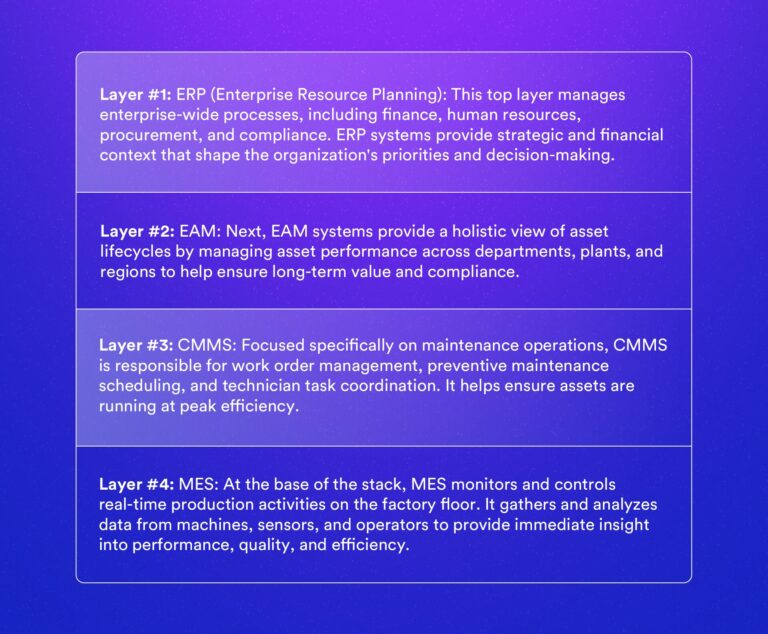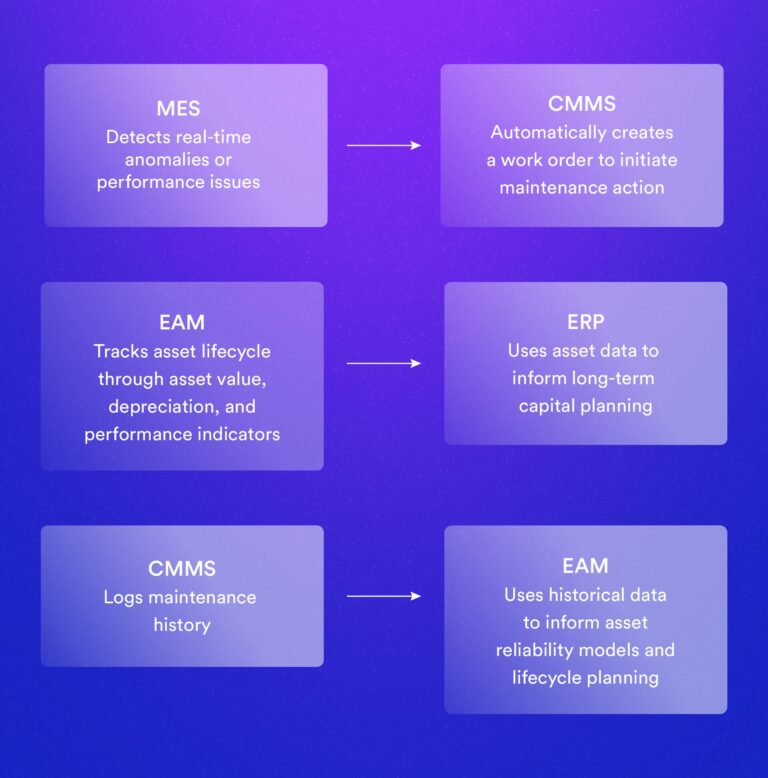Should your organization implement an Enterprise Asset Management (EAM) system? What about a Computerized Maintenance Management System (CMMS)? Maybe both? The answer isn’t simply a matter of “which technology is better,” but rather, which solution is best aligned to your organization’s scope, scale, and business goals.
Though they are similar, comparing these two technologies is not apples to apples. A CMMS is specifically tailored to manage maintenance operations, while EAM is a much broader system, encompassing a variety of business functions, including maintenance, fleet management, warranty tracking, contract management, and beyond.
So. Which system—or systems—are right for you? Read on to find out.
Table of Contents
Defining CMMS and EAM

Now, let’s dig into more in-depth definitions.
What is CMMS?
A Computerized Maintenance Management System (CMMS) streamlines and centralizes maintenance operations. It helps organizations schedule, track, and document maintenance activities that keep manufacturing equipment and facilities running efficiently.
Key CMMS functionalities:
- Work order management and tracking
- Preventive maintenance scheduling
- Inventory and spare parts management
- Equipment maintenance history
- Labor tracking and reporting
What is EAM?
Enterprise Asset Management (EAM) is a comprehensive software solution that helps manufacturers manage the entire lifecycle of physical assets—machinery, fleet vehicles, buildings, and more. An effective EAM helps companies minimize maintenance costs and ensure compliance.
Core EAM modules:
- Asset lifecycle management
- Financial asset tracking and depreciation
- Risk and compliance management
- Strategic asset planning
- Multi-site asset coordination
- Supply chain integration
CMMS vs. EAM: 5 Key Differences
Based on the definitions above, the difference between CMMS and EAM may seem clear. However. There are further distinctions you should consider before implementing a system.
Data Inputs
CMMS utilizes data such as equipment downtime, technician hours, work order histories, and service schedules to provide valuable intel that can optimize routine maintenance and identify equipment bottlenecks.EAM ingests a wide range of data, including asset financials, lifecycle performance, energy consumption, and procurement records. This variety of data supports budgeting, asset valuation, and long-term performance forecasting.
User Interface (UI) Accessibility
CMMS interfaces are tailored to maintenance teams; they’re mobile-friendly and designed for rapid input in field environments. Features like barcode scanning and offline access are also common.EAM platforms are designed for users from various teams, including maintenance, finance, operations, and more. They feature complex dashboards, customizable views, and tools for analytics and strategic planning.
Implementation Complexity
As CMMS focuses on only maintenance, implementation tends to be relatively quick. Training is often minimal, focusing on navigation and task execution.EAM implementation requires cross-departmental alignment. Data must be standardized, and teams need proper training to ensure appropriate use. While up-front implementation can be extensive, EAM systems provide long-term scalability and strategic alignment.
Integration Capabilities
Common CMMS integrations include IoT devices, condition monitoring systems, and simple financial tools.Designed to integrate with enterprise systems, EAM systems can connect to ERPs, procurement suites, supply chain management systems, and more.
Scalability & Flexibility
While scalable to a degree, CMMS expansion typically involves layering on additional tools.EAM platforms are built with scalability in mind; they have modular configurations that can support multiple locations, departments, and asset types. Custom workflows, user roles, and automation tools can be tailored to meet evolving business needs.
Understanding the Operational Technology Stack
Modern manufacturing environments are highly connected. Business leaders must understand how various systems work together to drive operational efficiency.
Neither CMMS nor EAM systems work in isolation. They inform critical layers in a broader technology stack, including platforms like ERP and MES. To best visualize where CMMS and/or EAM fit in, consider this example of a four-layer technology hierarchy:


Conclusion
Both EAM and CMMS can provide value to your manufacturing operations—though in different ways.
CMMS platforms excel at streamlining maintenance, while EAM solutions offer a broader, lifecycle-focused approach to asset management. Understanding their core differences is key to knowing which (or both!) are best for your organization’s unique needs.
Questions around which of these solutions may best round out your existing technology stack? Contact us today.

